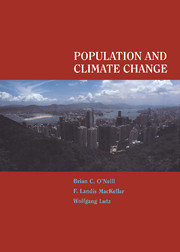Book contents
- Frontmatter
- Contents
- Foreword
- Preface
- Authors and Contributors
- Acknowledgments
- PART I
- PART II
- 4 Population and Greenhouse Gas Emissions
- 5 Population and Adaptation: Agriculture, Health, and Environmental Security
- 6 Population and Climate Change: Policy Implications
- Appendix I Fertility and Mortality Assumptions for IIASA Population Projections
- Appendix II Household-level Economies of Scale in Energy Consumption
- Appendix III Population in Major Climate Change Assessment Models
- References
- Index
5 - Population and Adaptation: Agriculture, Health, and Environmental Security
Published online by Cambridge University Press: 23 December 2009
- Frontmatter
- Contents
- Foreword
- Preface
- Authors and Contributors
- Acknowledgments
- PART I
- PART II
- 4 Population and Greenhouse Gas Emissions
- 5 Population and Adaptation: Agriculture, Health, and Environmental Security
- 6 Population and Climate Change: Policy Implications
- Appendix I Fertility and Mortality Assumptions for IIASA Population Projections
- Appendix II Household-level Economies of Scale in Energy Consumption
- Appendix III Population in Major Climate Change Assessment Models
- References
- Index
Summary
As pointed out in Chapter 1, historical greenhouse gas (GHG) emissions have committed the world to some climate change even if aggressive mitigation policies are put into place immediately. Societies therefore have an incentive to plan for adaptation to climate change impacts no matter how much emissions are reduced. In this chapter, we ask whether slower population growth would enhance the ability of institutions, especially in developing countries, to adapt to the likely impacts of climate change. In 20, 50, and certainly in 100 years, some countries that are currently poor will no longer be so. However, others will, and large subpopulations may remain poor even in countries that attain average living standards much higher than they enjoy today. In considering the impacts of climate change, it is important to impose a hypothetical unfavorable climate not on the world of today, but on the world as it may be decades in the future. Nonetheless, both the geographical distribution of expected climate change impacts and a concern for equity suggest a focus on low-income settings.
We focus on three aspects of human welfare that may be threatened by climate change: agriculture, health, and environmental security. In Chapter 3, we developed a model of population–economy–environment interactions, emphasizing the theme that while stresses to populations in low-income settings can set off a destructive series of effects, policy intervention can encourage virtuous responses as well. Vicious-circle reasoning is also key to our understanding of how population growth affects the ability of societies to respond to the threats posed by climate change in these three areas.
- Type
- Chapter
- Information
- Population and Climate Change , pp. 143 - 183Publisher: Cambridge University PressPrint publication year: 2000



